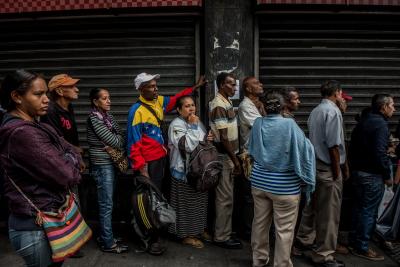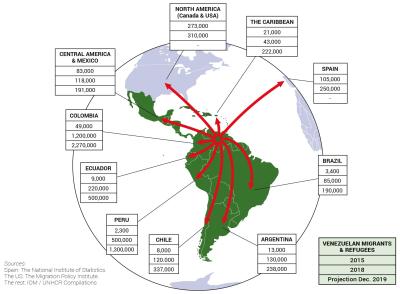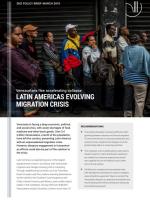Latin Americas evolving migration crisis

© Meridith Kohut/The New York Times/Scanpix Ritzau.
Venezuela is facing a deep economic, political, and social crisis, with acute shortages of food, medicine and other basic goods. Over 3.4 million Venezuelans, a tenth of the population, have left the country, presenting Latin America with an unprecedented migration crisis. However, diaspora engagement in humanitarian efforts could also be part of the solution to the crisis.
■ UN efforts to complement humanitarian help with development assistance to poorer reception areas should be supported. Ways to connect the Venezuelan diaspora to ongoing humanitarian and future development efforts directed at Venezuela should also be pursued.
Latin America is experiencing one of the largest displacement crises in its history with Venezuelan migrants and refuges crossing into or transiting through neighbouring countries such as Colombia, Brazil, Ecuador and Peru, before reaching destinations further afield in the Southern Cone (Argentina and Chile), Central America and Mexico, and smaller island states in the Caribbean. During 2018 over 838,000 Venezuelans exited Colombia, of whom more than 70 percent crossed into Ecuador. In Europe, Spain has seen the largest influx of Venezuelans, with over 150,000 having entered the country over the past three years. The United Nations High Commissioner for Refugees (UNHCR) and the International Organization for Migration (IOM) estimate that the number of internationally displaced Venezuelans will reach 5,385,000 by the end of 2019, few of whom have any prospects returning in the short to medium term.
If this happens, the Venezuelan exodus could eventually produce a refugee crisis comparable to those seen in war-ravaged countries such as Syria, Afghanistan and South Sudan.
Ironically, Venezuela’s booming oil economy once attracted migrants and refugees. In the period following World War II, many southern Europeans found refuge in Venezuela, as did Latin Americans fleeing dictatorships and civil wars during the 1970s and early 1980s, as well as Colombia’s more than fifthy years of armed conflicts. While many less settled migrants returned to their countries of origin when crisis hit the Venezuelan economy in the late 1980s/early 1990s, others add to the group who are currently leaving the country.
Many reasons for leaving
People leave Venezuela for a combination of reasons, including a lack of access to food and medicine, a loss of income and the absence of effective national protection systems, increasing insecurity and violence, massive violations of human rights and political persecution of those considered in opposition to the government.
As in other refugee crises, the financially better off or better educated were among the first to leave. Many of the current refugees are disadvantaged financially and educationally, their health status is poor after years of malnutrition, and many are exhausted from having travelled long distances on foot. Due to problems related to unstable exchange rates and poor security conditions, several airlines have stopped operating in-and-out of Venezuela, leading to a severe increase in prices. Thus, air routes have increasing been replaced by land and maritime routes, which in the case of irregular border crossings make Venezuelans vulnerable to exploitation, extorsion, human trafficking, gender-based violence, discrimination and xenophobia.
Latin American responses to Venezuelan migrants
For decades, Latin America has contributed substantially to the pursuit of protection of refugees and migrants, largely by maintaining an open-door policy. Amid a changing political landscape, the magnitude of the Venezuelan exodus has made migration a top priority for countries in the region.
Prompted by the crisis, the major receiving countries like Colombia and Peru have granted temporary residence permits through the Colombian Special Stay Permit (PEP) and the Peruvian Temporary Stay Permit (PTT). In both countries, Venezuelans have access to basic social rights and may work. Ecuador, often praised for its progressive migration policy, allows those persons who enter the country through regular means a temporary tourist visa for up to 180 days. Once in the country, foreigners can take up both temporary and later permanent residence, but work permits are more difficult to obtain, the cost being beyond the reach of most Venezuelan migrants.
A growing number of countries in the region are introducing restrictions on regular migration and reinstating visa requirements for Venezuelans. Instances of refoulement, detention and deportation are on the rise
Argentina, which from the mid-2000s has worked progressively to implement a rights-based human mobility policy, began to modify the country’s migration laws in 2017. The human right to migrate is no longer recognized in the current law, and steps have been taken to implement an electronic visa system and more rigid border controls, citing mainly the need to combat human smuggling and trafficking. In support of the Venezuelan opposition movement, Argentina has established a special assistance program for Venezuelan migrants in January 2019, facilitating their entry, regularization and social inclusion.
The steady increase in the number of Venezuelans arriving in Brazil, especially in the poor border state of Roraima, has led to social tensions. One of the first decisions taken by the new Bolsonaro government in January 2019 was to withdraw from the United Nations Global Compact on Migration, and steps have been taken to modify border controls and criminalize migration.
A growing number of countries in the region are introducing restrictions on regular migration and reinstating visa requirements for Venezuelans. Instances of refoulement, detention and deportation are on the rise.

The anti-migration rhetoric used by the new right in Latin American politics in many ways resembles discourses promoted by far-right groups in Europe in response to the Syrian refugee crisis. The sense of solidarity with fellow Latin Americans is declining and has already led to xenophobic incidents, for instance in Roraima (Brazil, August 2018) and Ambato (Ecuador, January 2019).
Increase engagement by the diaspora
The Joint UNHCR and IOM Regional Response Plan for Refugees and Migrants from Venezuela, for January-December 2019, advocates a coordinated and comprehensive region-wide approach to cope with the scale of the Venezuelan influx. The plan corresponds well to both the policy development needs of the governments of impacted countries and the immediate humanitarian needs of Venezuelan migrants and refugees. In addition it aims to bridge the ned for a humanitarian emergency response with a longer-term development perspective. The plan is silent, however, when it comes to involving the Venezuelan diaspora in ongoing humanitarian and development efforts. Future planning could benefit from expanding engagement by the diaspora, both in terms of facilitating individual and collective remittance transfers and in engaging diaspora network in achieving social change in Venezuela.
April 2013:Vice President Nicolás Maduro, who took office after Chavez’ death the previous year, narrowly defeats opposition candidate Capriles. Opposition supporters take to the streets.
February 2014: Months of public unrest seeking to oust Maduro culminates with the arrest of opposition leader Leopoldo Lopez.
December 2015: The opposition wins control over Venezuela’s legislative body, the National Assembly.
March 2017: Venezuela’s pro-government Supreme Court takes over the functions of the National Assembly, fueling months of anti-government protests.
July 2017:Venezuela calls a referendum to approve the creation of a new Constituent Assembly, nominally tasked with rewriting the constitution but actually taking over crucial legislative functions.
May 2018: President Maduro wins what many believe to be fraudulent presidential elections.
January 2019:Against the advice of the Lima Group, Maduro takes up his second term. Juan Guaidó assumes leadership of the National Assembly and shortly thereafter invokes Venezuela’s constitutional crisis provisions which empower the president of the National Assembly to assume interim presidency of the country to restore democratic order. He is quickly recognized as the legitimate president by the United States, the European Union and the 14 countries constituting the Lima Group. Russia and China support Maduro.
February 2019:On February 23 attempts to get humanitarian aid across the Venezuelan border fails. Two people are killed and 300 are wounded. Following the event, more than 200 Venezuelan soldiers leave their posts. Whereas the European Union demand new elections to restore democracy, the United States remain open to military intervention.
February 1999:
DIIS Experts


